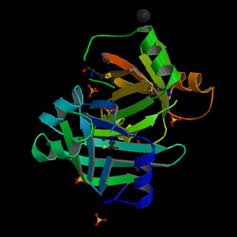
Handy Links
SLAC News Center
SLAC Today
- Subscribe
- Archives: Feb 2006-May 20, 2011
- Archives: May 23, 2011 and later
- Submit Feedback or Story Ideas
- About SLAC Today
SLAC News
Lab News
- Interactions
- Lightsources.org
- ILC NewsLine
- Int'l Science Grid This Week
- Fermilab Today
- Berkeley Lab News
- @brookhaven TODAY
- DOE Pulse
- CERN Courier
- DESY inForm
- US / LHC
SLAC Links
- Emergency
- Safety
- Policy Repository
- Site Entry Form

- Site Maps
- M & O Review
- Computing Status & Calendar
- SLAC Colloquium
- SLACspeak
- SLACspace
- SLAC Logo
- Café Menu
- Flea Market
- Web E-mail
- Marguerite Shuttle
- Discount Commuter Passes
-
Award Reporting Form
- SPIRES
- SciDoc
- Activity Groups
- Library
Stanford
Around the Bay
SSRL Plays Major Role in Identifying Protein Structure
 If the blueprint of life is DNA, then the building blocks it calls for are the proteins that make up living tissues. These proteins come in a vast menagerie of shapes and sizes, which can be arranged into families, numbering in the tens of thousands.
If the blueprint of life is DNA, then the building blocks it calls for are the proteins that make up living tissues. These proteins come in a vast menagerie of shapes and sizes, which can be arranged into families, numbering in the tens of thousands.
Over the last decade, scientists have mapped out the genomes of countless organisms, identifying all the genes and giving us a first glimpse of the secrets behind life's blueprints. However, until now, knowing the function of a protein, encoded by a particular gene, has often remained elusive.
Knowing a protein's structure and shape can tell us a lot about its function. Researchers at the Joint Center for Structural Genomics (JCSG) have taken up the task of mapping the structures of representative proteins from a diverse set of organisms. This monumental task is only just beginning, but progress is accelerating, according to Ashley Deacon, group leader for the Structure Determination Core, which is based at the Stanford Synchrotron Radiation Laboratory (SSRL).
"Genomes have been sequenced for many organisms, across all kingdoms of life," Deacon said. "Basically, we're now developing industrial scale technologies to solve the structures of the proteins involved."
Mapping protein structure requires sophisticated x-ray diffraction facilities, such as those at the protein crystallography beamlines at SSRL. This capability has made SSRL one of the cornerstones of the JCSG project.
The Structure Determination Core at SSRL is one of three JCSG research groups. The Bioinformatics Core (based at the University of California San Diego and the Burnham Institute) is responsible for determining which proteins to study, and the Crystallomics Core (based at The Scripps Research Institute and the Genomics Institute of the Novartis Research Foundation) produces sets of crystallized samples of those proteins. Researchers at SSRL then study the protein samples, using x-ray diffraction to map out the arrangement of atoms within each protein molecule. As each structure is mapped out, or "solved," the results are posted to a public database known as the Protein Data Bank (PDB). The group recently posted their 300th protein structure, a milestone that Deacon says marks the beginning of real progress.
"The project's been going for six years, and we've done over 100 structures the last year alone," Deacon says.
The JCSG pilot project started in 2000, and this year marked the beginning of a full-scale production center. Research continues around the clock, 365 days a year, even during the SSRL shutdown (see previous SLAC Today article). From bacteria to humans, the project will map proteins common to an incredible diversity of organisms.
Protein structure studies are central to the development of new drugs and help scientists understand important biological processes. As more structures become known, we can also learn how biological structure and function have evolved.
"This project is important to understanding fundamental biological processes," Deacon said. "Once you have a broad collection of proteins, you can also work out the relationship between a gene sequence and the protein's structure and function."
The JCSG project is funded by the National Institute of General Medical Sciences (NIGMS), as part of the Protein Structure Initiative (PSI) of the National Institutes of Health.
—Brad Plummer
SLAC Today, September 14, 2006
Above image: Graphical representation of a protein molecule from a common type of bacteria posted to the Protein Data Bank by JCSG.